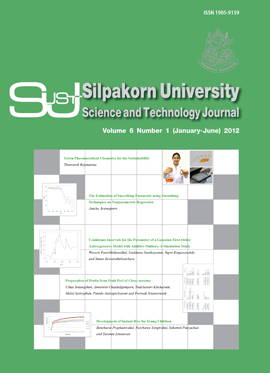Preparation of Pectin from Fruit Peel of Citrus maxima
Main Article Content
Abstract
The extraction of high-methoxyl pectin from the fruit peel of Citrus maxima was studied. The suitablecondition was the extraction at 80 °C without pH adjustment (pH was about 4.5) in 20 times by volume ofwater. For up-scale procedure, the peel was pre-soaked in water for overnight to wash out small molecularwater-soluble substances. Amberlite XAD-16 polystyrene was used to remove phenolic compounds beforeconcentration and precipitation of pectin. This suggested method was simple and inexpensive. The yieldof the obtained pectin was 7.23±0.19%. Its galacturonic acid content and degree of esterification were74.12±2.07% and 76.30 ±3.38%, respectively.
Downloads
Download data is not yet available.
Article Details
How to Cite
Sotanaphun, U., Chaidedgumjorn, A., Kitcharoen, N., Satiraphan, M., Asavapichayont, P., & Sriamornsak, P. (2013). Preparation of Pectin from Fruit Peel of Citrus maxima. Science, Engineering and Health Studies, 6(1), 42–48. https://doi.org/10.14456/sustj.2012.3
Section
Research Articles
References
Ali Sahari, M., Ali Akbarian, M., and Manuchehr, H. (2003). Effect of variety and acid washing method on extraction yield and quality of sunflower head pectin. Food Chemistry, 83(1): 43-47.
Chaidedgumjorn, A., Sotanaphun, U., Kitcharoen, N., Asavapichayont, P., Satiraphan, M., and Sriamornsak, P. (2009). Pectins from Citrus maxima. Pharmaceutical Biology, 47(6): 521–526.
Ehrlich, R. M. (1997). Method for making pectin and pectocellulosic products. United States Patent, 5,656,734. Aug 12.
Huong, D. M., and Luyen, D. V. (1989). Optimization of pectin extraction from dried peel of Citrus grandis. Polymer Bulletin, 22(5-6): 599-602.
Joye, D. D., and Luzio, G. A. (2000). Process for selective extraction of pectins from plant material by differential pH. Carbohydrate Polymers, 43(4): 342-337
Kalapathy, U., and Proctor, A. (2001). Effect of acid extraction and alcohol precipitation conditions on the yield and purity of soy hull pectin. Food Chemistry, 73(4): 393-396.
May, C. D. (1990). Industrial pectins: sources, production and applications. Carbohydrate Polymers, 12(1): 79-99.
Minkov, S., Minchev, A., and Paev, K. (1996). Modelling of the hydrolysis and extraction of apple pectin. Journal of Food Engineering, 29(1): 107-113.
Novosel’skaya, I. L., Voropaeva, N. L., Semenova, L. N., and Rashidova, S. Sh. (2000). Trends in the science and application of pectins. Chemistry of Natural Compounds, 36(1): 1-10.
Rolin, C. (1993). Pectin. In Industrial Gums: Polysaccharides and Their Derivatives. (Whistler, R. L., and BeMiller, J. N., eds.), pp. 258-293. Academic Press, New York.
Schieber, A., Hilt, P., Streke, P., Endreb, H. U., Rentschler, C., and Carle, R. (2003). A new process for the combined recovery of pectin and phenolic compounds from apple pomace. Innovative Food Science & Emerging Technologies, 4(1): 99-107.
United States Pharmacopeial Convention. (2002). The United States Pharmacopeia-The National Formulary (USP 26-NF21). pp. 1401-1402. Webcom Limited, Toronto.
Voragen, A. G. J., Pilnik, W., Thibault, J. F., Axelos, M+. A. V., and Renard, C. M. G. C. (1995). Pectins. In Food Polysaccharides and Their Applications. (Stephen A. M., edt.), pp. 287-369. Marcel Dekker, New York.
Wang, C. C. H., and Chang, K. C. (1994). Beet pulp and isolated pectin physiochemical properties as related to freezing. Journal of Food Science, 59(6): 1153-1154.
Willats, W. G. T., McCartney, L., Mackie, W., and Knox, J. P. (2001). Pectin: cell biology and prospects for function analysis. Plant Molecular Biology, 47(1-2): 9-27.
Chaidedgumjorn, A., Sotanaphun, U., Kitcharoen, N., Asavapichayont, P., Satiraphan, M., and Sriamornsak, P. (2009). Pectins from Citrus maxima. Pharmaceutical Biology, 47(6): 521–526.
Ehrlich, R. M. (1997). Method for making pectin and pectocellulosic products. United States Patent, 5,656,734. Aug 12.
Huong, D. M., and Luyen, D. V. (1989). Optimization of pectin extraction from dried peel of Citrus grandis. Polymer Bulletin, 22(5-6): 599-602.
Joye, D. D., and Luzio, G. A. (2000). Process for selective extraction of pectins from plant material by differential pH. Carbohydrate Polymers, 43(4): 342-337
Kalapathy, U., and Proctor, A. (2001). Effect of acid extraction and alcohol precipitation conditions on the yield and purity of soy hull pectin. Food Chemistry, 73(4): 393-396.
May, C. D. (1990). Industrial pectins: sources, production and applications. Carbohydrate Polymers, 12(1): 79-99.
Minkov, S., Minchev, A., and Paev, K. (1996). Modelling of the hydrolysis and extraction of apple pectin. Journal of Food Engineering, 29(1): 107-113.
Novosel’skaya, I. L., Voropaeva, N. L., Semenova, L. N., and Rashidova, S. Sh. (2000). Trends in the science and application of pectins. Chemistry of Natural Compounds, 36(1): 1-10.
Rolin, C. (1993). Pectin. In Industrial Gums: Polysaccharides and Their Derivatives. (Whistler, R. L., and BeMiller, J. N., eds.), pp. 258-293. Academic Press, New York.
Schieber, A., Hilt, P., Streke, P., Endreb, H. U., Rentschler, C., and Carle, R. (2003). A new process for the combined recovery of pectin and phenolic compounds from apple pomace. Innovative Food Science & Emerging Technologies, 4(1): 99-107.
United States Pharmacopeial Convention. (2002). The United States Pharmacopeia-The National Formulary (USP 26-NF21). pp. 1401-1402. Webcom Limited, Toronto.
Voragen, A. G. J., Pilnik, W., Thibault, J. F., Axelos, M+. A. V., and Renard, C. M. G. C. (1995). Pectins. In Food Polysaccharides and Their Applications. (Stephen A. M., edt.), pp. 287-369. Marcel Dekker, New York.
Wang, C. C. H., and Chang, K. C. (1994). Beet pulp and isolated pectin physiochemical properties as related to freezing. Journal of Food Science, 59(6): 1153-1154.
Willats, W. G. T., McCartney, L., Mackie, W., and Knox, J. P. (2001). Pectin: cell biology and prospects for function analysis. Plant Molecular Biology, 47(1-2): 9-27.

